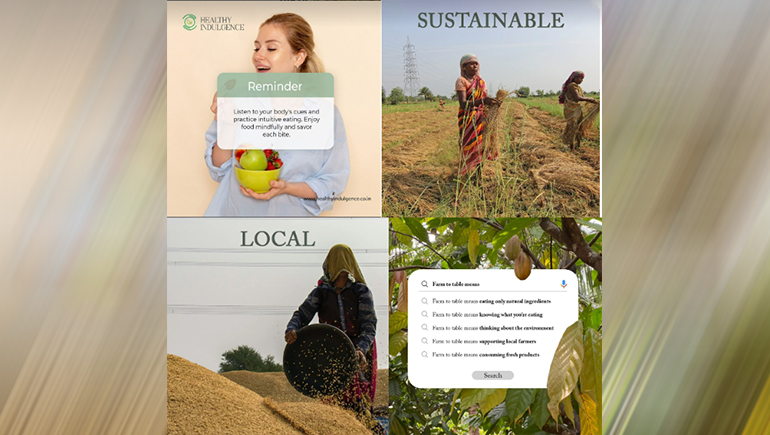
Veg vs Non-veg as a binary choice is an integral part of Indian eating habits and Indian food culture. At one level, this is a simple classification, referring to food habits and preferences for what to eat - vegetarian or non-vegetarian food. Vegetarian refers to plant eating + dairy (no meat) and non-vegetarian refers to meat eating.
Of course, food habits and practices in India, have never fitted into this simple binary. Indian food practices have always made room for those who are eggetarians, piscetarians (think Bengali brahmins) and so on. As well as those who eat non-veg, but won't do so on Saturdays and Tuesdays or who eat only veg at home but will eat non-veg out-of-home or under dire pressure when travelling abroad. Thus, the veg-non-veg binary of eating habits has over time, translated to a wide range of positions in terms of actual practices.
In contemporary food discourse, we find more evolution and change in the conceptual architecture around the veg-non-veg binary. The old idea of "We are what we eat" has come back with a vengeance into multiple food ideologies.
From our Indian cultural origins, we find the renewed old concept of "Sattvik" lifestyle, as a kind of step forward from simple vegetarianism.
From the West, we find a new expression of the veg-non-veg binary that suits their new found discovery of food sources - Plant sourced Food and Animal sourced Food. This labelling of source as plant vs. animal is the outcome of Veganism, which outlaws dairy products. So, from plant vs. meat, we now have plant vs. animal.
Both Sattvik lifestyle and Veganism are more than just a food choice. They are ideologies and belief systems that you need to sign up to, in order to continue with the food choices on a daily basis. Given the cultural origins of each, Indic vs. Western, the ideologies are bound to be constructed differently.
Let's start by looking more closely into Veganism.
From the Western socio-cultural space, Veganism emerged as a philosophy and lifestyle in the 1940s, primarily as a response to animal cruelty and ethical concerns around the treatment of animals. It is rooted in the belief that animals should not be exploited for food, clothing or any other purpose. It promotes animal rights, compassion, and in recent times, environmental sustainability too.
Environment sustainability has now become their top priority. Vegans are ardent advocates for reducing the environmental impact of animal agriculture, which is associated with deforestation, greenhouse gas emissions, water pollution, and other environmental issues. Bearing the flag of animal welfare, Vegans abstain from consuming all animal-derived products, including meat, poultry, fish, dairy, eggs, honey, and other animal-derived ingredients. They focus on a plant-based diet that includes fruits, vegetables, whole grains, legumes, nuts, and seeds.

They believe in compassion - kindness to one another, therefore this is the reason they are found to be pro LGBTQ community, respecting gender and sexuality of all beings. In this ideology, the level of strictness and adherence to following a plant-based diet can vary among individuals. Some vegans may have additional personal beliefs or dietary preferences that influence their choices within the framework of veganism.
Moving on to the Sattvic Lifestyle, it stems from the ‘sattva guna’ which means living a pure, harmonious, and healthy life. In the Indian context, emerging from the ancient Vedic scriptures is the sattvic lifestyle based on the principles of Ayurveda and Yoga. In the teaching of traditional yoga, foods are categorised into Gunas which translates to qualities or nature in Sanskrit. There are three Gunas: sattva, rajas, and tamas. The rajasic lifestyle derived from the rajas guna upholds the feeling of passion, anger, stress, and restlessness whereas the tamasic lifestyles of the tamas guna resonate with a feeling of lethargy and dullness.
The Sattvic Ahaar comprises eating fresh fruits, vegetables, lentils, nuts, seeds, and dairy products. It refuses the consumption of rajasic foods (foods that make you restless) and tamasic foods (foods that lead to dullness and lethargy).
The core of the sattvic lifestyle is inner reflection and seeking spiritual development. The aim here is to be one with the higher self, to be in sync with nature. Yoga and meditation therefore play pivotal roles in the Sattvic Lifestyle, enabling the practitioner to look inward and reflect for putting mind, body, and soul in harmony. Since humans are considered an integral part of nature, the consumption of animal meat is seen as an act against nature. Being Sattvic to achieve spiritual growth is the ultimate motto of this ideology. There are fundamental differences between Veganism and the Sattvic Lifestyle, although at the food habits level, there could be a lot of similarity. In terms of diets, a vegan diet can be sattvic but not all sattvic diets are vegan!

Vegans compared to Sattvic lifestyle followers are less motivated towards inner self-reflection and are more conscious observers of the world outside. Veganism has a Western approach that is based on raising a voice against anything that is against animal rights and harmful to the environment. Followers of Veganism are tuned into environmental concerns, challenge the law and protest in solidarity.

The third direction in contemporary food culture is based on fitness and wellness. With growing health consciousness amongst young fitness enthusiasts, what one eats is of high importance as diet forms 70% of the fitness regime. Eating clean, preservative-free, and gut-healthy food promotes metabolism and helps in building muscles.
Eating seasonal, local, and fresh produce is the healthy mantra that is highlighted by fitness experts and nutritionists in the industry. Being mindful about the macro and micronutrients on your plate and eating nutritious meals are nothing short of medicines that would help your body heal and help people stay active. Fitness experts aren't concerned about the veg-non-veg, plant-animal binary. They are more concerned about eating seasonal-local-fresh foods and being conscious of what one is eating, whether it will promote better health or will take away from good health.

Action Points for Food Brands:
Today, packaged food brands need to be aware of the food discourse arising from food ideologies. It is no longer enough to create products based on needs and highlight good taste and product quality in communication. While ma-ke-haath-ka-khana (food as love and nurture) and grandmother's traditional recipes will continue to resonate as positioning platforms, the source of food, the type of farming, farm-to-fork, environmental impact, impact on mental health and well-being are all part of the food discourse taking place on social media. Brands need to know and align themselves to these qualities and world-views as well.








.jpg)



.jpg)




Leave a Comment